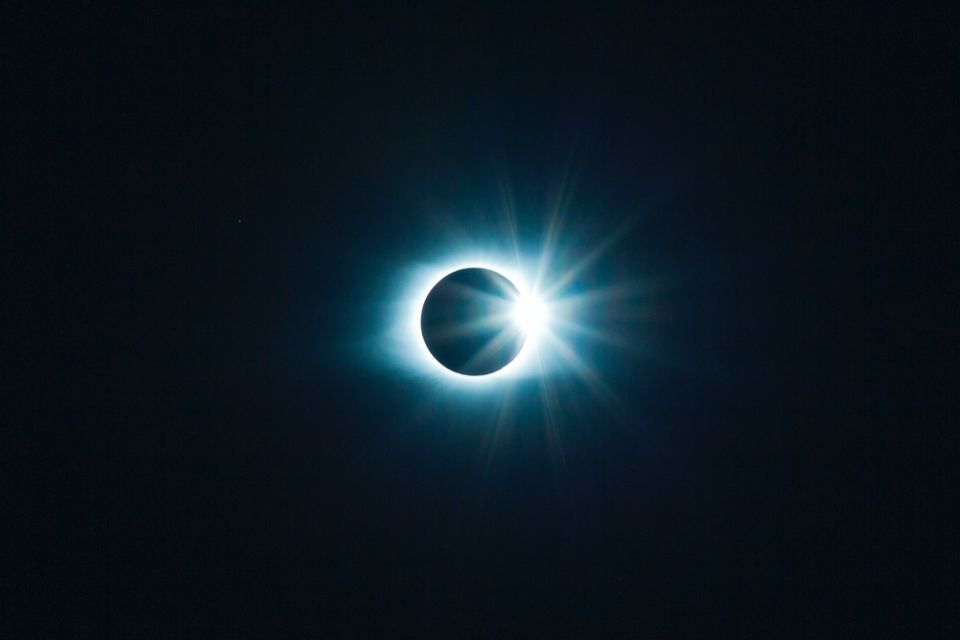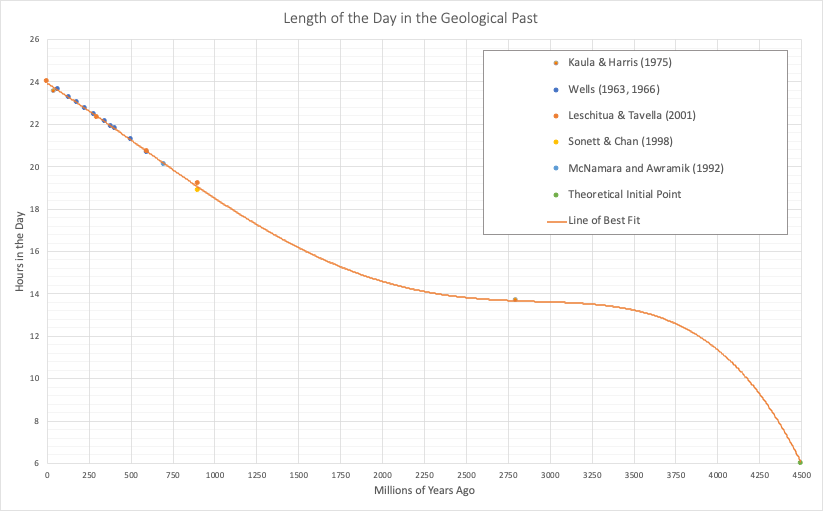Deep Trends - The Lunar Retreat

The moon is gradually retreating from the earth. As it orbits it pulls on the earth, and it is this clutching motion which is largely responsible for the tides. In turn, the tides generate friction which slows the earth's spin, making the day 1.8 milliseconds longer each century.
And the earth pushes back against the moon, accelerating it into a wider orbit – as such, the earth and the moon are currently drifting away from each other at the rate of 3.8cm/year.
Mostly for my own interest, I wanted to know what this would look like over geological timescales – whether these trends were linear, what it would have meant for the early life and the global climate, and how it compares to other I thought this might be the first of a series which examines some of the deep trends of the past.
Theoretical minimum
We don't know exactly how the moon was formed, but the leading hypothesis is that it was created when a Mars-sized planet (nicknamed Theia) collided with the proto-earth, sending a 'rooster-tail' cloud of debris into orbit which coalesced into the moon. This theory is attractive because it explains why the moon is far less dense than the earth, as lighter materials would have been ejected into space during the collision. Likewise, it partially explains why the geological composition of the moon is almost identical to that of earth, as both proto-planets would have contributed material to the moon and the earth.
Under this model, the moon would have been formed between 4.51 billion and 4.47 billion years ago, and it would have solidified at (or just beyond) the earth's Roche limit, at a distance of just 17,000 km away. At this point in the distant past, the day would have been just six hours long, as the impact from Theia would have sped-up the earth's rotation like spinning a basketball on their finger. This gives us our theoretical starting point for the earth-moon binary system.
The Solar Day and the Lunar Retreat
We don't have direct records of the length of the day in prehistory, of course, and so we have to rely upon proxy indicators to work out how many days in the year there were at different points in the geological past. One way to do this is to examine coral fossils for periodic annulations which hint at the duration of the month, and make comparisons with contemporary coral growth rates to determine the length of the day.
Taking these studies, and others like them, I plotted them out on a chart and used a line of best fit to determine an approximate trend.

It's obvious that a linear trend wouldn't fit, so the rate of lunar retreat must have shifted over time. This has been attributed to major upheavals in the earth's past which would have frustrated the tides – the redistribution of landmasses, for example, and the Paleoproterozoic, Cryogenian and Cenozoic glaciations. In more recent times, melting glaciers have released more water to contribute to the tides, and this has in turn
We find a similar picture when we try to plot the lunar retreat. Dr James O'Donoghue, who has put together some excellent astronomical visualisations in recent years, made the following video which demonstrates how the distance of the moon has changed over these same timescales. We can see that the rate of change has varied significantly – starting out very high at first, and eventually oscillating back and forth between 2mm and 7cm per year. In more recent times, over the last few tens of thousands of years, melting glaciers have contributed more water to the tidal effect which has sped-up the lunar retreat.
One implication of this trend is that solar eclipses weren't always a thing – the moon would have been too large in the sky and would have completely obscured the sun – and eventually the moon will retreat so far away that the dramatic ring effect will start to blur and lose much of its impact. We might be living in a brief, two-billion year era in which the solar eclipse produces its dramatic, polarised-light effect.
Upshot
This leaves us with a few takeaways:
- We are living in a brief moment in time in which the day lasts 24 hours, but this was not always the case. So we can use the length of the day as a short-hand for talking about events in the deep past – when trilobites first emerged, for example, the day was only 21 hours long, and it was 22.5 hours long at the time they became extinct. I think this might become especially useful as I investigate further trends in the deep past.
- I made my own chart myself mostly because I couldn't find a graphic which satisfyingly illustrated the concept. This is because there still only appear to be a few studies in this area of geochronology, so what we currently know could be radically upset by a future discovery. I would watch this space for future developments.
- The slowing rotation of the earth and the lunar retreat are complex and variable processes, sensitive to geological, climatic and even biological factors. As the glaciers melt due to anthropogenic global warming not only will our global climate be affected, but also the celestial motions of the earth and moon. In this sense, the Anthropocene will, amongst other things, herald our inadvertent attempt at engineering the solar system.
Please let me know if you think I've made an obvious error. I'll continue to update this series as I come across similar trends.
Photo credits: Photo by Tyler van der Hoeven / Unsplash
Graph References
Kaula, W. K. & Harris, A. “Dynamics of Lunar Origin and Orbital Evolution,” Review of Geophysics and Space Physics, 13, 363, 1975.
Leschiutta, S. & Tavella P., “Reckoning Time, Longitude and The History of the Earth’s Rotation, Using the Moon” Earth, Moon and Planets, 85-86 : 225- 236, 2001.
McNamara, K.J, Awramik, S.M., 1992. Sci. Progress 76, 345.
Sonett, C. P. and Chan, M. A. “Neoproterozoic Earth-Moon Dynamics : rework of 900 million ago Big Cottonwood Canyon tidal laminae” Geophysics Research Letters, 25(4), 539-542.1998
Wells, John W., “Paleontological Evidence of the Rate of the Earth’s Rotation”, Earth-Moon System, edited by Marsden & Cameron, Plenum Press, 1966. pp. 70-81.
Wells, John W., Nature, 197, 948-950, 1963.

Comments ()